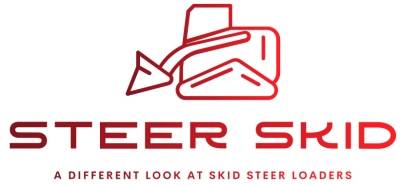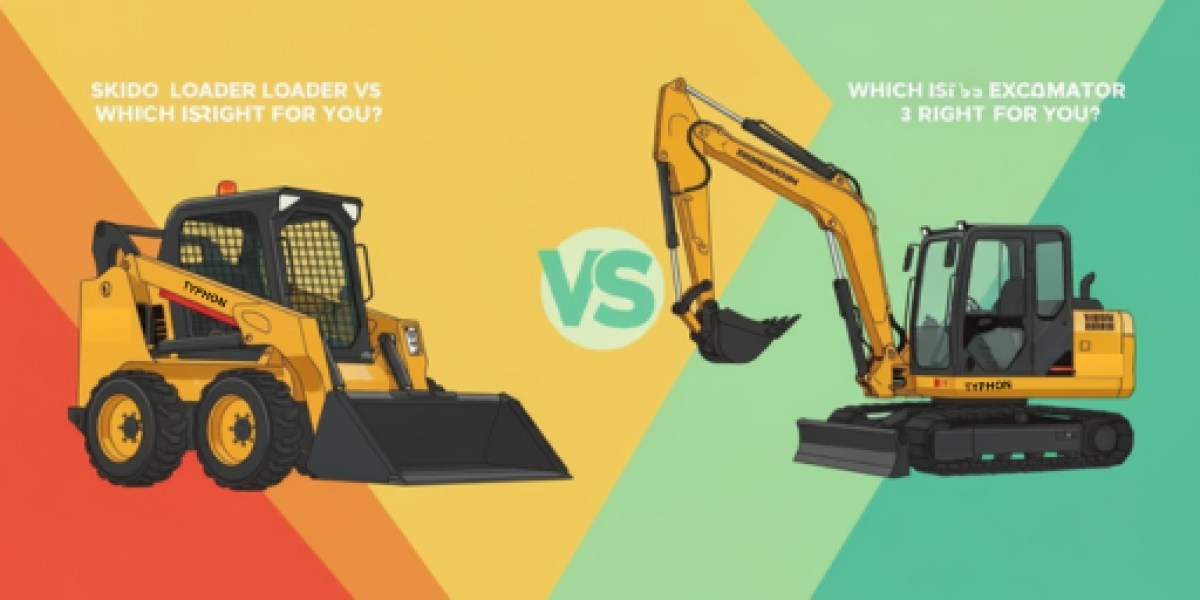Introduction to Earthmoving Machines
Why Compare Skid Steers and Excavators?
Selecting the appropriate heavy equipment is crucial when managing a building project, starting construction on a new site, or seeking ways to refurbish your garden. Skid steer loaders and excavators are the two most frequently used as well as extremely versatile machines in the construction and landscaping sectors.
While these machines are equally necessary for the moving of earth and making jobs less cumbersome, they come with distinctive pros and cons and are differently used. Grasping these distinctions will enable you to save your time, money, and unnecessary hassle by matching the right machine to the task at hand.
If you are a contractor, property owner, or someone who aspires to operate this equipment, gaining knowledge about the functions of these machines in comparison to others will afford you an advantage that can help you be more efficient on the work site down the line.
Overview of Their Role in Construction and Landscaping

What is an excavator?
Design and Operational Mechanism
An excavator is a machine that is specially designed for digging with a part that can be turned in a circle or on its axis (the upper part, also called a house), a stick and a boom for various extensions, and a mounted tool or bucket at the end. Excavation vehicles operate on tracks and are efficient at moving heavy soil, performing deeper trenching work, and accurately lifting objects.
Main features are as follows:
- Cab that can be rotated and has a 360-degree rotation capability
- Hydraulic-activated boom and stick
- Stable configuration due to wide tracks with the help of the counterweight located at the rear
The swivel seat allows operators to monitor the boom while operating the machine. The mini-excavator is a smaller version of the excavator, whereas the large ones are made for industrial purposes.
Types of Excavators and Their Applications
There is a broad range of excavators, including the following:
- Mini excavators are used for light jobs in small spaces.
- Crawler excavators: These are known for their heavy-duty operations like grading and trenching over very difficult terrain.
- Wheeled excavators: They are mainly utilized in urban and less harsh pavement areas.
- Long-reach excavators: Such excavators come into play for the activities of dredging, demolition, and for the deeper depths of the excavation process.
Usual tasks:
- Acquiring the foundations of buildings and digging trenches
- Demolishing buildings
- Moving heavy objects
- Site grading and leveling
- Dredging rivers or ponds
Excavators are the best machines for all the precision work in cases where exact digging or lifting is needed, specifically in the building of a large construction.
Head-to-Head Comparison: Skid Steer vs Excavator
Size and Maneuverability
- Skid Steer: The skid steer is small, agile, and can turn 360o in its own footprint. It is an extremely good machine for situations where space is limited or in urban areas.
- Excavator: It is comparative to the skid steer but has the advantage of a rotating cab to work in a larger area.
Winner: Skid steer for tight spaces; excavator for broader reach and depth.
Versatility and Attachments
- Skid Steer: It can be attached with various tools and equipment that turn it into various types of machines and a master in performing a plethora of works.
- Excavator: Digging is the main job it does, however, it can be supported by such implements as breakers, grapples, and augers.
Winner: Skid steer for multitasking; excavator for specialized digging.
Digging Capability and Precision
- Skid Steer: The skid steer has the option of making a hole, but it cannot control the depth or width like the excavator.
- Excavator: The excavator cannot only do digging, but it does so with precision, greater depth, and reach.
Winner: Excavator
Terrain Adaptability
- Skid Steer: The hard surface is suitable for a skid-steered vehicle, but the tracked model is more adaptable to muddy or snowy environments.
- Excavator: The stability of the tracks has been a game-changer in terms of slopes, as well as uneven and waterlogged ground, which now poses no problem.
Pros and Cons of Excavators
Advantages
Excavators are heavy hitters in the earthmoving world. Their features make them indispensable for large-scale and precision digging projects:
- Superior Digging Ability: With deep reach and strong hydraulics, they can excavate foundations, trenches, and slopes effortlessly.
- 360-Degree Operation: A revolving cabin on the excavator allows the operator to dig, lift, and swing materials without shifting the machine.
- Heavy Lifting Capacity: Among other things, these pieces of machinery handle the heavy weight of stones or the movement of trees and treetops.
- Great for Demolition: With the help of excavator-mounted hammers or grapples, it is possible to make wrecking a building or breaking up concrete an easy and efficient job.
The most suitable places are those necessary for excavation, demolition, preparatory work, site logging, and building.
Disadvantages
Apart from their considerable strength, excavators have a few handicaps as well:
Humcho: Precision operation requires more skill, especially in congested job sites.
Application of a Skid Steer Loader
You should use a skid steer if you are:
- Working in tight residential spaces
- Performing a multiple attachment task
- Grading, loading, or shifting materials
- Doing light trenching or post-hole digging
- Operating on a well-surfaced, flat area
It’s the appropriate vehicle for small and medium-sized projects with a variety of tasks.
When to Use an Excavator
Choose an excavator if you require:
- Deep digging or long-reach excavation
- Heavy lifting or demolition capability
- Working on slopes, ditches, or unstable ground
- Precision trenching or pond dredging
- To rotate and dig in multiple directions without moving the base
Excavators are most suitable for large, technical, or terrain-sensitive jobs.
Cost and Maintenance Comparison
Deciding between the machines is also a matter of cost—both initial and ongoing.
Fuel Efficiency and Maintenance Needs
- Skid Steers:
- Use less fuel
- Less time and cheaper to maintain
- Hydraulic and mechanical system components are easy to understand and manage
- Excavators:
- Conservatively use gasoline (particularly large vehicles)
- Hydraulics that are more intricate and have more wear points
- Routine maintenance is also part of being the machine with the heavier workload
It is evident that the amount of time the machine spends on maintenance and the costs of repairing excavators will usually be on the higher side, especially in difficult operating situations.
Which One Should You Choose?
As there isn’t one clear solution that is right for every situation, it is essential, therefore, to select the one that is most catered to your particular needs…
Job Type Considerations
- If your work involves light-to-moderate tasks with a variety of work, buy a skid steer.
- Are you into deep excavations or demolition? Then an excavator is what you need.
Space and Terrain Factors
- For the skid steer, if the surroundings and area are tight and confined or the work is done indoors, then go skid steer.
- If the place is vast, uneven, or has raising of heavy materials, then go excavator.
Long-Term Project Planning
A skid steer is likely to be the right choice if you require a versatile machine that is also capable of clearing a variety of tasks, not just excavation. However, if your sole focus is on excavation or demolition, then a new digger will make a better investment because it comes with a greater long-term return and productivity.
On a further note, it’s quite common among the professionals to see both machines used togethe ?>:
Final Thoughts
Now, regardless of whether you choose a skid steer loader or an excavator, it is not always easy to tell which one is the best—there is only the right tool for the right job. Both machines are essential in construction, landscaping, and agricultural industries, but they have their strong and weak points.
- A skid steer loader is an all-in-one tool. It can be used with an incredible variety of attachments, and its small size makes it a good option for works that have various things to be done at the same time, in the case of limited space, and even for the people who want it for their house for everyday use. It can be utilized at the same time of day and on conjoining tasks. Snow removal and damage clearing are some of the tasks that the skid loader performs without asking; these are the basics of city maintenance.
- Conversely, an excavator is the ultimate drama queen in terms of deep excavation, trenching, and tearing down edifices. In case you need a job to be done with the utmost power, depth, and a larger range, an excavator is the best option for you. It is intended for controlled work and lifting operations on a larger scale and under high conditions of stress.
Knowing their strengths—and areas they are not so strong in—helps in the placement of the machinery. There are occasions when the most prudent course of action is to have both machines on the same site, with each managing the tasks that suit it best.
So, whether you choose to hire construction equipment for a weekend job or to set up a business unit of the same, the thing to do is to make sure that the machine is the exact match for the task to be done.
Thus, to the maximum extent, the productivity of the project will be increased, the delays will be minimized if there are any at all, and the project will be more likely than not on budget.

